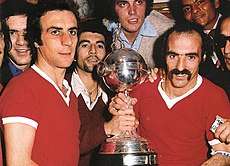Club Atlético Independiente
 | ||||
| Full name | Club Atlético Independiente | |||
|---|---|---|---|---|
| Nickname(s) |
El Rojo (The Red) Los Diablos Rojos (The Red Devils) Rey de Copas (King of Cups) | |||
| Founded | 1 January 1905 | |||
| Ground |
Estadio Libertadores de América, Avellaneda, Argentina | |||
| Capacity | 48,069 | |||
| President | Hugo Moyano | |||
| Manager | Ariel Holan | |||
| League | Primera División | |||
| 2017–18 | 6th | |||
| Website | Club website | |||
|
| ||||
Club Atlético Independiente (Spanish pronunciation: [ˈkluβ aˈtletiko indepenˈdjente]) is an Argentine professional sports club, which has its headquarters and stadium in the city of Avellaneda in Greater Buenos Aires. The club is best known for its football team, which plays in the Primera División and is considered one of Argentina's Big Five football clubs. The club holds a long-standing rivalry with neighbor Racing Club de Avellaneda in the Avellaneda derby, referred to as El Clásico de Avellaneda.
Independiente was officially founded on 1 January 1905, although the institution had been formed on 4 August 1904 and had already played in Argentina's first division. Originally from Monserrat, a historic neighborhood of Buenos Aires, the club moved to Avellaneda in 1907. The football team has won 16 Primera División titles (the last one was the 2002 Apertura) and 9 National cups.
In international club football competitions, Independiente has won a total of 20 titles,[1] 18 of them being organised by CONMEBOL[2] and other associations. Independiente's achievements include a record of seven Copa Libertadores won, being the only club to win four finals in a row, between 1972 and 1975. The club has won the Copa Interamericana three times, the Supercopa Sudamericana twice, the Recopa Sudamericana once, the Intercontinental Cup twice (1973 and 1984), and the Copa Sudamericana twice, in 2010 and 2017. The 2018 Suruga Bank Championship was its most recent achievement. Other international titles won by Independiente include two Rioplatense Copa Aldao competitions, organized by Argentine and Uruguayan Associations together.[3]
Apart from football, other activities practised at the club are athletics, basketball, boxing, chess, field hockey, futsal, handball, gymnastics, martial arts, Pilates, roller skating, scuba diving, swimming, tennis, volleyball, water polo and yoga.[4]
History
Foundation
Independiente was founded on 4 August 1904. A group of employees from a shoes store located in Buenos Aires city founded a football club called Maipú FC. The mostly young employees were only allowed to watch the games; they could not play for the team. As a result, at a meeting in a bar located in front of the club, they chose to form a new club. The name chosen was "Independiente" to mark their independence from Maipú FC.

Rosendo Degiorgi was appointed interim president. Degiorgi's family offered the use of a small room in their home to serve as the first club headquarters. It was established the Sunday 1 January 1905 as the official foundation date. Arístides Langone was elected first president of the institution, and it was proposed by him to adopt white with details in blue as the club's colors, inspired by team St. Andrew's, the first champions of football in Argentina winners of 1891 season.
Independiente played the first game on his history on Sunday 15 January 1905, against Atlanta, in the "bohemios" field, losing 1–0. The next game was played on 22 January 1905 against Maipú Banfield F.C., which ended in a 0–0 draw. The club won the first game in its history with a resounding 11–0 win against Albion on 7 May 1905. Independiente then got affiliated to The Argentine Football Association, and was allowed to play in the second and third divisions. The first "Avellaneda derby" was played on 9 June 1907. Independiente beat Racing 3–2.
That same year Independiente moved from Buenos Aires to its new field located in Avellaneda city, which was built in Manuel Ocantos street.
On 10 May 1908, the team played for the first time wearing the red jersey, in a match against Banfield that Independiente won 9–2. The adoption of the red color is subject to controversy; the most recognized version is the one by decision of president Arístides Langone, who became surprised watching English team Nottingham Forest in a tour winning by a trashing 6–0 against Alumni AC, the strongest Argentine club on that era, so he decided to adopt the Forest's colors.[5]
In 1909, the Independiente F.C. won its first trophy; the 1909 Copa Bullrich, a domestic cup for second tier teams.[6] Goalkeeper José Buruca Laforia was one of the first star players on Independiente.
Promotion to first tier
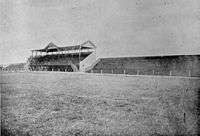
Independiente became an Argentine top division team in 1912, taking part in 1912 FAF Primera Division. Since there were a conflict between some clubs, the football league was dividided into two leagues with their own separate federation (AAF and FAF), and only a few teams remained in FAF, so the federation invited Independiente, among other teams.
With politician and club president Juan Mignaburu as head coach,[7] the team finished in first place along with CA Porteño at 20 points. Goal difference wasn't used and the teams had to play a playoff match, with Porteño winning the championship as a result of Independiente abandoning the match in protest at a disallowed goal by referee. League's top scorer was Independiente striker Enrique Colla, with 12 goals.[8]
At the 1910s, the Avellaneda derby between Independiente and Racing Club de Avellaneda was the most popular confrontation, ahead of the "Superclásico" between River Plate and Boca Juniors.
Although being one of the most popular teams, Independiente did not win any league on that decade. They instead won some domestic first division trophies; 1914 Copa de Competencia La Nación (awarded), 1917 Copa de Competencia Jockey Club (defeating Estudiantes de La Plata, 2–1) and the 1918 Copa de Honor (beating CA Platense, 1–0).[9]
With the obtention of cup titles, Independiente qualified for the first time to rioplatense competitions (international titles between Argentine and Uruguayan teams), both resulting in defeat; 1917 Tie Cup (to Montevideo Wanderers, 0–4)[10] and 1918 Copa de Honor Cousenier (to CA Peñarol, 0–4).[11]

In early the 1920s Independiente won its first league title, the 1922 AAmF Primera División whereas football in Argentina was still split in two separated leagues.[12] Next league title was the 1926 AAmF Primera División season.[13] Both championships featured Manuel Seoane as top scorer, giving Independiente a lot of power in attack along with Luis Ravaschino and future Italian world champion Raimundo Orsi.
Due to Independiente's powerful attack, media gave the nickname Diablos Rojos (Red Devils) to the team, which quickly became popular among fans and remained identifying the team since then. The club also won consecutively the 1922, 1923 and 1924 editions of the AAmF Copa de Competencia, beating Club Almagro, Sportivo Palermo and CA Lanús respectively at the finals.[14]
In 1923 the Rojos for the first time faced a European team, with Scottish team Third Lanark touring in Argentina. The Argentines won by 2–1 with two goals from Orsi.[15] Later in 1928 the red team defeated a less wealthy FC Barcelona by 4–1,[16] and one year after, touring team Chelsea FC visited Independiente resulting in a 1–1 tie, with Seoane scoring for el Rojo.[17]
After the 1927 season, Raimundo Orsi left and joined Juventus F.C..[18] Later in 1928 the club built the Estadio Doble Visera, the first stadium in Latin America made entirely of cement, and second in the world after the Harvard Stadium. Formerly, football stadiums in Latin America consisted simply on tribunes and seats made of wooden planks.
1930s

1931 was the Argentine Primera División's first season as a fully professional league. In the early 30s, Independiente finished as runners-up in 1932, 1934, 1935 and 1937.[19]
Manuel Seoane retired in 1933, having become the Argentine Primera División's amateur era top scorer, with 241 goals in 264 matches.[20]
In the next years arrived to the club Vicente de la Mata, Arsenio Erico and Antonio Sastre; Independiente's first legends. Arsenio Erico was a young Paraguayan who came to Argentina to avoid fighting at the Chaco War for his country. Then he became the Argentine Primera División's top scorer on three consecutive seasons; 1937, 1938 and 1939, while Antonio Sastre was considered the best footballer in Argentina's history on that times.
With a wonderful squad, the team won the 1938 Primera División[21] and 1939 Primera División[22] seasons, three domestic cups (one Copa Adrián C. Escobar in 1938, and two Copa Ibarguren in 1938 and 1939),[23] and its first two international titles; the Copa Ricardo Aldao on its 1938 and 1939 seasons, defeating CA Peñarol (3–1 in Montevideo) and Nacional de Montevideo (5–0 in Buenos Aires) respectively.[24]
The 1940s and 1950s
Independiente achieved several overwhelming victories in early the 1940s, including an 8–1 win over Estudiantes de La Plata, 7–1 over Boca Juniors and 7–0 over Racing Club, which are still to this days, the worst defeat on those teams' history. In 1945 it was Independiente' turn to suffer its biggest defeat; 0–8 to CA Vélez Sarsfield.
Although having a lethal offensive, Independiente were crowned champions nine years later, at the 1948 Primera División season, with former team's goalkeeper Fernando Bello as head coach[25]
In 1946 goal scorer Arsenio Erico left the club after 325 official matches and 295 goals, having become in Argentine Primera División and Independiente's all-time top scorer.[26] Antonio Sastre left in 1942[27] and Vicente de la Mata remained till 1950, winning the 1948 championship.
Independiente did not win any trophy in the 1950s. This is the only decade in the club's history to not win any title. Its best position was 2nd place in 1954.[28] In 1953 the Rojos won 6–0 on a friendly match against Real Madrid on a European tour, with star player Alfredo Di Stefano playing for the Spanish team. The tour also included victories against Valencia CF (3–0), Atlético de Madrid (5–3), Benfica (2–1) and Sporting CP (8–1).[29]
In 1958, Independiente inspired Ecuadorian team Independiente del Valle's founders to adopt the Argentine team's name. Initially, the forementioned team also featured the same colors and a similar emblem.[30] They now compete regularly at the Ecuadorian Serie A.
70s and 80s; success at continental and world stages
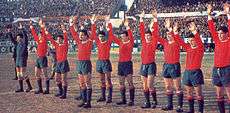
Independiente won three league titles at the 60s decade; 1960,[31] 1963[32] and 1967.[33] However, at the time of this last one, Independiente was already making his first steps towards South American glory.
After the 1960 title, the team participated for the first time at a continental championship with its participation at the 1961 Copa Libertadores, losing both quarter-finals legs against SE Palmeiras.[34]
The team won their first continental title by defeating Nacional de Montevideo at the 1964 Copa Libertadores Finals after a scoreless draw in Uruguay and a 1–0 win at home, having previously disqualified title holders Santos FC which featured several Brazilian world champion players like Pelé,[35] becoming the first Argentine team to win the competition.[36]
They would also win the 1965 Copa Libertadores, this time after defeating Boca Juniors at semi-finals and Uruguay's other big team, CA Peñarol (4–1 at neutral match held in Estadio Nacional de Chile).[37]
Being the CONMEBOL champions, Independiente contested twice the Intercontinental Cup but lost both to Italian powerhouse Inter Milan. After a win for each other, the teams played a third match play-off in Santiago Bernabeu Stadium in Spain to decide the 1964 title, with Internazionale winning in extra time with a goal from Mario Corso. For the 1965 edition, Inter won 3–0 on aggregate.[38]
Again, Independiente started a new decade by winning two league titles in a row; 1970,[39] 1971[40] and, later in the same decade, the 1977[41] and 1978[42] editions of the National Championship. The 1977 title is especially remembered by the club as an historic triumph, as the team managed to win the finals against Talleres de Córdoba with a goal from Ricardo Bochini, assisted by Daniel Bertoni, after suffering three players being polemically sent off by the referee. The 1978 title came after a 2–0 win against River Plate in the finals.
Independiente's greatest achiviements in the 70s were conquering the premier continental competition again, and this time with a record four times in a row. In fact, the Diablos Rojos won the 1972 Copa Libertadores defeating Universitario of Peru,[43] the 1973 Copa Libertadores after a third playoff match in Estadio Centenario against Colo-Colo,[44] 1974 Copa Libertadores after another playoff match held in Santiago de Chile against Brazil's São Paulo FC,[45] and 1975 Copa Libertadores against Unión Española.[46] After the 1973 title, Independiente became the team with most Libertadores titles.

Success at the Intercontinental Cup was short. The 1972 edition resulted in loss against AFC Ajax Amsterdam and the 1974 one went to Atlético de Madrid's showcases. However the Argentine side managed to win the 1973 Intercontinental Cup against Juventus F.C., on a single match held at Stadio Olimpico in Rome, where Ricardo Bochini scored to give Independiente a 1–0 win. Another edition was to be contested with FC Bayern Munich in 1975 but it was never played.[47]
The club also obtained three times in a row the Interamerican Cup; in 1973, 1974 and 1976 defeating Club Deportivo Olimpia, CSD Municipal and Atlético Español respectively,[48] going through the penalty shootout in 1974 and 1976.
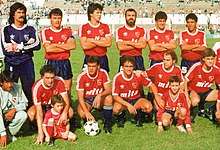
At the 80s Independiente won the 1983 Torneo Metropolitano after a 2–0 away victory against city archirrivals Racing Club de Avellaneda, who suffered relegation to Primera B division as well, resulting in another historic moment for the team and his supporters.[49] Later on, Independiente won the 1988–89 Primera División season.[50]
The 1983 domestic title served as qualifying for the 1984 Copa Libertadores. Independiente advanced to second stage after tying with Club Olimpia at 9 points, whereas the Rojos had a better goal difference than the Paraguayans. Again, the team advanced as Nacional de Montevideo and CD Universidad Católica where both defeated and Independiente went to a new continental final match. Jorge Burruchaga scored to settle a 1–0 away win against Brazilian side Grêmio and, after a scoreless draw at Avellaneda, Independiente won his seventh Copa Libertadores title.[51]
The season ended successfully after a 1–0 win against Liverpool F.C. at Tokyo National Stadium in Japan to win the 1984 Intercontinental Cup and claim their second world title. Goal was scored by José Alberto Percudani at the first half.[52]
Independiente reached the 1989 Supercopa Sudamericana Finals, having beaten Santos FC, Atlético Nacional and Argentinos Juniors. But no goals where scored in the two legs against compatriots Boca Juniors and the red team lost on penalty shootout.[53]
The 1990s and 2000s titles
The 90s started with the retirement of Ricardo Bochini in 1991. A one club man, in his 20 years of professional football from 1972 to 1991 Bochini played only for Independiente (apart from the Argentina national football team), and participated in the club's Golden Era, with 8 international titles, and 4 Argentine championships. He played a total of 740 matches, scoring 107 goals.[54]
Independiente would then win the 1994 Clausura at national level, while in the next semester, the team won the 1994 Supercopa Libertadores, starting at the round of 16 and beating consecutively the Brazilian teams Santos FC, Grêmio and Cruzeiro EC. Like in 1989, the finals were contested by Argentina's two international-experienced football teams, Independiente and Boca Juniors, with Independiente winning the title with a 1–1 draw in La Bombonera and a 1–0 win at home with a wonderful goal from Sebastián Rambert.[55]
With its new international triumph, Independiente contested and won the 1995 Recopa Sudamericana against Copa Libertadores winners Vélez Sarsfield in a single match held in Tokyo, Japan, thanks to a single goal by José Serrizuela.[56]
A new international title came into Independiente's showcases as they managed to defend the title at the 1995 Supercopa Libertadores after a 2–1 aggregate score over Brazil's Flamengo, becoming the first foreign team to be crowned at the Maracanã Stadium.[57] The club now had reached 15 international trophies. However, this time failed to repeat the Japanese held Recopa and lost the 1996 Recopa Sudamericana by 1–4 to Grêmio at the Kobe Universiade Memorial Stadium.[58]
In Argentine summer 2002, Uruguayan striker Diego Forlán was signed by Manchester United for £7.5 million[59] and the result was loss of practically all attack power. Independiente for the first time finished last at the Argentine league at the 2002 Clausura, scoring 14 goals in 19 games.[60]
However the next semester the team achieved their next title by being crowned champions of the 2002 Apertura. This team is very well remembered because of its offensive trident composed by Andrés Silvera, Federico Insúa and Daniel Montenegro, three players with some future at the national team, while being defended by Gabriel Milito.[61]
In 2006 the club sold its young star Sergio Agüero to Atlético de Madrid with a transfer fee of $28 million,[62] becoming Argentina's biggest sale up to this days. Kun made his senior team debut against San Lorenzo in 2003 with only 15 years and one month, what made him the youngest player to ever debut in the Argentinean league.[63] With other remarkable players being sold to European teams like Oscar Ustari and Germán Denis, president Julio Comparada announced the building of new and modern Estadio Libertadores de América, whose construction was finished in 2016 due to various debts and finnancial problems.
First relegation and comeback
After 15 years without international titles, Independiente once again returned to South American elite by being crowned champions of the 2010 Copa Sudamericana after beating Brazilian side Goiás EC at the penalty shootout in the finals, with Independiente hosting the second leg. As a funny fact, the Brazilian team reached the finals after being relegated to Série B in Brazilian championship, and Independiente being located at the bottom place of the Argentinian league.[64]
The following year, Independiente lost the 2011 Recopa Sudamericana to Brazilian team SC Internacional after a 2–3 aggregate.[65]
When Independiente's president, Julio Comparada, was replaced with Javier Cantero, the later revealed severe economic problems, that could bring Independiente to an end if they are not dealt accordingly. He revealed that the club had a liability of AR$600 million ($129 million US dollars), debts with former players and managers and various providers and banks.
Campaigns in Primera División where accordingly to the club's institucional crisis and the team wasn't able to reverse its poor form, and was relegated to the Primera B Nacional for the first time in its history, after the 2012–13 Primera División.[66] The president Javier Cantero resigned a few months later, after a team's seven matches winless run at the B Nacional.[67]
However, soon after that, the influential leader Hugo Moyano took over the club by winning the elections. The team, after being in relegation spots to Primera B Metropolitana for almost two months, managed to reverse is form with Omar De Felippe's managerial and reached and won a promotion play-off against CA Huracán by 2–0 at a single match. Independiente went back to Primera División and in its first tournament after their return, the team earned an unexpected 4th place.
Three years later, with Ariel Holan as head coach and some international players like captain Nicolás Tagliafico, Fabricio Bustos, Maximiliano Meza, Alan Franco, Gastón Silva, and Martín Campaña, Independiente reached once again the elite level on Argentine football and won the 2017 Copa Sudamericana after beating Brazil's popular club Flamengo in the finals.[68]
After the finals took place, the club sold youngster Ezequiel Barco to Atlanta United by a transfer fee of $15 million, setting an all-time record transfer for the Major League Soccer.[69] They also won the 2018 Suruga Bank Championship held in Japan against Cerezo Osaka,[70] and participated in the 2018 Recopa Sudamericana against Copa Libertadores winners Grêmio, but lost in the penalty shootout.[71]
Kit uniform and badge
Badge evolution
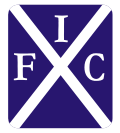 1905–14 1
1905–14 1 1907 2
1907 2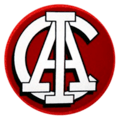 1925 3
1925 3 1914–present
1914–present
Notes:
- 1 This crest (inspired on Saint Andrew's') is still used in the away uniform since the 1980s.
- 2 First seal of the club when it adopted red as main color.
- 3 It was not an official emblem although it was painted on one of the grandstands in 1925.
Kit manufacturers and shirt sponsors
| Period | Kit manufacturer | Shirt Sponsors |
|---|---|---|
| 1979–81 | Adidas | None |
| 1982–85 | Topper | |
| 1985–86 | Mita | |
| 1986–88 | Le Coq Sportif | |
| 1988–92 | Adidas | |
| 1992–97 | AdeS | |
| 1997–98 | Topper | Topper |
| 1999–00 | Termidor | |
| 2000–01 | AdeS | |
| 2001–02 | None* | |
| 2002–04 | Taranto | |
| 2004–05 | Umbro | |
| 2005–06 | Forjar Salud | |
| 2006–09 | Grupo Márquez | |
| 2009–11 | Puma[72] | Motomel & Powerade |
| 2011–12 | Motomel & Ibupirac | |
| 2012–14 | TCL & Ibupirac | |
| 2014–18 | OCA & Banco Ciudad | |
| 2018– | Caminos Protegidos y Audifarm | |
*Independiente.com appeared in place of shirt sponsor to promote the club's new website.
Stadium
The "Estadio Libertadores de América" is a stadium located in Avellaneda, Buenos Aires Province. The stadium was officially named only as recently as 2005, having been previously known simply as "Estadio de Independiente" or "La Doble Visera de Cemento (The double cement visor") because of the two roofs overhanging the spectators.
On 4 March 1928, in a match against Peñarol of Uruguay that ended in a draw, Independiente established the first concrete stadium in South America and would host all international finals Independiente played as local team (7 of the Copa Libertadores, 3 of the Intercontinental Cups, 2 of the Supercopa Sudamericanas and 2 of the Interamericanas Cup) as well as many Argentina international matches, mostly in the 1930s and 1940s.
The Estadio Libertadores de América was closed for repairs in 2007, and reopened on 28 October 2009 in a league match against Colón de Santa Fe, which Independiente won 3–2. During construction, Independiente played their home games in four different stadiums.
Players
Current squad
- As of 1 September 2018
Note: Flags indicate national team as defined under FIFA eligibility rules. Players may hold more than one non-FIFA nationality.
|
|
Out on loan
Note: Flags indicate national team as defined under FIFA eligibility rules. Players may hold more than one non-FIFA nationality.
|
|
All-time top scorers
| No. | Player | Position | Goals | Played |
|---|---|---|---|---|
| 1 | F | 293 | 325 | |
| 2 | F | 233 | 264 | |
| 3 | F | 152 | 362 | |
| 4 | F | 136 | 285 | |
| 5 | F | 112 | 340 | |
| 6 | M | 97 | 638 | |
| 7 | F | 90 | 173 | |
| F | 90 | 194 | ||
| F | 90 | 219 | ||
| 8 | F | 89 | 193 | |
| 9 | F | 80 | 179 | |
| 10 | F | 77 | 163 | |
Top-scorers by season
The following tables lists the players that have been named top scorers playing for Independiente in Primera División. Independiente has 15 top scorers.[73][74]
| Tournament | Player | Goals |
|---|---|---|
| 1912 FAF | 12 | |
| 1922 AAm | 55 | |
| 1924 AAm | 15 | |
| 1926 AAm | 29 | |
| 1929 AAF | 13 | |
| 1937 | 48 | |
| 1938 | 43 | |
| 1939 | 41 | |
| 1956 | 17 | |
| 1966 | 23 | |
| 1967 Nacional | 11 | |
| 1982 Metropolitano | 20 | |
| 1999 Clausura | 17 | |
| 2002 Apertura | 16 | |
| 2007 Apertura | 18 |
Gallery
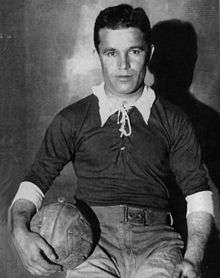 Luis Ravaschino played 11 years for the club scoring 136 goals.
Luis Ravaschino played 11 years for the club scoring 136 goals. Manuel Seoane, all-time 2nd. top scorer with 241 goals.
Manuel Seoane, all-time 2nd. top scorer with 241 goals.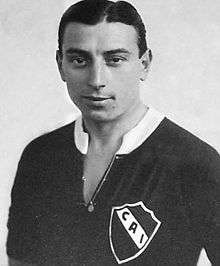 Raimundo Orsi played during the 1920s before his success in Italy.
Raimundo Orsi played during the 1920s before his success in Italy. Arsenio Erico, the all-time Primera División top scorer with 295 goals.
Arsenio Erico, the all-time Primera División top scorer with 295 goals. Vicente de la Mata, who played 362 games for Independiente.
Vicente de la Mata, who played 362 games for Independiente. Antonio Sastre played 340 matches scoring 112 goals.
Antonio Sastre played 340 matches scoring 112 goals. Ernesto Grillo played 9 years for the club scoring 90 goals.
Ernesto Grillo played 9 years for the club scoring 90 goals. Raúl Bernao played from 1961 to 1970 winning two Copa Libertadores.
Raúl Bernao played from 1961 to 1970 winning two Copa Libertadores. Miguel A. Santoro played 14 years, winning 10 titles.
Miguel A. Santoro played 14 years, winning 10 titles. Ricardo Pavoni made 423 appearances in 11 years playing for the club.
Ricardo Pavoni made 423 appearances in 11 years playing for the club.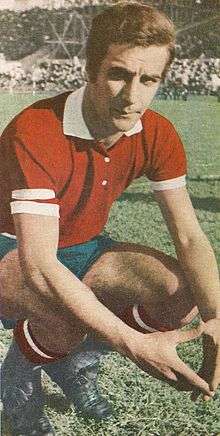 José Omar Pastoriza, a great scorer and a historical manager who won 5 trophies.
José Omar Pastoriza, a great scorer and a historical manager who won 5 trophies.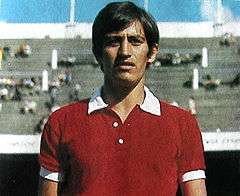 Héctor Yazalde was a great striker, scoring 72 goals in 5 years with Independiente.
Héctor Yazalde was a great striker, scoring 72 goals in 5 years with Independiente. Ricardo Bochini played all his professional career with the club, with 13 titles won.
Ricardo Bochini played all his professional career with the club, with 13 titles won. Jorge Burruchaga won 4 international Cups during his two tenures on Independiente.
Jorge Burruchaga won 4 international Cups during his two tenures on Independiente.
Last managers
|
|
|
Honours
National
League
National cups
- Copa Ibarguren (2): 1938, 1939
- Copa Adrián C. Escobar (1): 1939
- Copa de Competencia La Nación (1): 1914
- Copa de Competencia Jockey Club (1): 1917
- Copa de Honor Municipalidad de Buenos Aires (1): 1918
- Copa de Competencia (AAm) (3): 1924, 1925, 1926
- Copa Bullrich (1): 1909
International
- Intercontinental Cup (2): 1973, 1984 [note 1]
- Copa Libertadores (7): 1964, 1965, 1972, 1973, 1974, 1975, 1984 [note 2]
- Copa Sudamericana (2): 2010, 2017 [note 2]
- Recopa Sudamericana (1): 1995 [note 2]
- Suruga Bank Championship (1): 2018 [note 3]
- Copa Interamericana (3): 1973, 1974, 1975 [note 4]
- Supercopa Sudamericana (2): 1994, 1995 [note 2]
- Copa Dr. Ricardo Aldao (2): 1938, 1939 [note 5]
- Notes
Notes
- ↑ Along with Ricardo Lucarelli of Sportivo Buenos Aires, who also scored 15 goals.
- ↑ Along with Juan Cortesse of San Lorenzo, who also scored 13 goals.
- ↑ Along with Juan Castro, player of Rosario Central, who also scored 17 goals.
- ↑ The "Asociación Amateurs de Football" (AAm) was a dissident league which organized its own championships from 1919 to 1926.
References
- ↑ Independiente campeón en Japón: logró su vigésimo título internacional, Clarín, 8 August 2018
- ↑ Las competiciones oficiales de la CONMEBOL on Conmebol website, 19 Ago 2015
- ↑ Campeonato Rioplatense – Copa Dr. Ricardo C. Aldao (1913–1955) on RSSSF
- ↑ Deportes amateur on Independiente official site Archived 17 May 2012 at the Wayback Machine.
- ↑ https://www.ole.com.ar/independiente/Independiente-Nottingham-Forest-unidos-siempre_0_324567670.html
- ↑ http://www.rsssf.com/tablesa/argcuphist.html
- ↑ https://www.ole.com.ar/independiente/hizo-abajo_0_943105858.html
- ↑ http://www.rsssf.com/tablesa/arg12.html
- ↑ http://www.rsssf.com/tablesa/argcuphist.html
- ↑ http://www.rsssf.com/sacups/argurucuptie.html
- ↑ http://www.rsssf.com/sacups/arguruhonor.html
- ↑ http://www.rsssf.com/tablesa/arg22.html
- ↑ http://www.rsssf.com/tablesa/arg26.html
- ↑ http://www.rsssf.com/tablesa/argcuphist.html
- ↑ http://www.rsssf.com/tables/3rdlanark-satrip23.html
- ↑ http://www.diasdehistoria.com.ar/content/el-rojo-goleaba-4-1-al-barcelona-de-españ
- ↑ http://www.rsssf.com/tablesc/chelsea-satrip29.html
- ↑ https://web.archive.org/web/20050526084929/http://www.forza-juventus.com/biographies/orsi.htm
- ↑ http://www.rsssf.com/tablesa/argchamp.html
- ↑ http://www.rsssf.com/tablesa/argtops.html
- ↑ http://www.rsssf.com/tablesa/arg38.html
- ↑ http://www.rsssf.com/tablesa/arg39.html
- ↑ http://www.rsssf.com/tablesa/argcuphist.html
- ↑ http://www.rsssf.com/sacups/aldao.html
- ↑ http://www.rsssf.com/tablesa/arg48.html
- ↑ http://www.rsssf.com/players/ericodata.html
- ↑ http://www.elgrafico.com.ar/2015/05/19/C-8134-antonio-sastre-el-hombre-orquesta.php
- ↑ http://www.rsssf.com/tablesa/argchamp.html
- ↑ http://www.rsssf.com/tablesi/independiente-trip54.html
- ↑ http://www.marca.com/futbol/copa-libertadores/2016/07/16/578a00bde5fdea7d508b4579.html
- ↑ http://www.rsssf.com/tablesa/arg60.html
- ↑ http://www.rsssf.com/tablesa/arg63.html
- ↑ http://www.rsssf.com/tablesa/arg67.html
- ↑ http://www.rsssf.com/sacups/copa61.html
- ↑ https://www.gazetaesportiva.com/times/santos/independiente-goleou-time-de-pele-e-nunca-perdeu-para-o-santos-na-argentina/
- ↑ http://www.rsssf.com/sacups/copa64.html
- ↑ http://www.rsssf.com/sacups/copa65.html
- ↑ https://www.inter.it/es/palmares
- ↑ http://www.rsssf.com/tablesa/arg70.html
- ↑ http://www.rsssf.com/tablesa/arg71.html
- ↑ http://www.rsssf.com/tablesa/arg77.html
- ↑ http://www.rsssf.com/tablesa/arg78.html
- ↑ http://www.rsssf.com/sacups/copa72.html
- ↑ http://www.rsssf.com/sacups/copa73.html
- ↑ http://www.rsssf.com/sacups/copa74.html
- ↑ http://www.rsssf.com/sacups/copa75.html
- ↑ http://www.rsssf.com/tablest/toyota.html
- ↑ http://www.rsssf.com/tablesi/intam.html
- ↑ http://www.rsssf.com/tablesa/arg83.html
- ↑ http://www.rsssf.com/tablesa/arg89.html
- ↑ http://www.rsssf.com/sacups/copa84.html
- ↑ http://www.rsssf.com/tablest/toyota84.html
- ↑ http://www.rsssf.com/sacups/supcopa89.html
- ↑ https://elpais.com/diario/1991/07/05/deportes/678664812_850215.html
- ↑ http://www.rsssf.com/sacups/supcopa94.html
- ↑ http://www.rsssf.com/sacups/recopa94.html
- ↑ http://www.rsssf.com/sacups/supcopa95
- ↑ http://www.rsssf.com/sacups/recopa95.html
- ↑ http://www.soccerbase.com/players/player.sd?player_id=29892&season_id=131
- ↑ http://www.rsssf.com/tablesa/arg02.html
- ↑ http://www.rsssf.com/tablesa/arg03.html
- ↑ http://archivo.eluniversal.com.mx/notas/352663.html
- ↑ https://www.foxsports.com.ar/news/109225-aguero-10-anos-como-profesional
- ↑ https://int.soccerway.com/matches/2010/12/09/south-america/copa-nissan-sudamericana/ca-independiente/goias-esporte-clube/1051863/
- ↑ http://www.rsssf.com/sacups/recopa2010.html
- ↑ "Sin milagro, Independiente descendió por primera vez en su historia", Clarín, 15 June 2013
- ↑ Un final anunciado para Javier Cantero: renunció a la presidencia de Independiente (in Spanish)
- ↑ http://www.conmebol.com/es/independiente-campeon-de-la-conmebol-sudamericana-2017
- ↑ http://www.goal.com/en/news/atlanta-united-signs-ezequiel-barco-from-independiente/1246v6l3ue7u31vvow7ui4x1hk
- ↑ http://estadisticas.conmebol.com/html/v3/index.html?channel=deportes.futbol.suruga.424898&lang=es_LA
- ↑ http://estadisticas.conmebol.com/html/v3/index.html?channel=deportes.futbol.recopa.424897&lang=es_LA
- ↑ "Independiente sign Puma and Powerade kit deals". Football Shirt Culture. 7 January 2009. Retrieved 23 April 2017.
- ↑ Argentine First Division Top Scorers, by the RSSSF
- ↑ Estadísticas históricas de Primera División
External links
| Wikimedia Commons has media related to Club Atlético Independiente. |
